Advertisements
Advertisements
प्रश्न
Why do we get a spectrum of seven colors when white light is dispersed by a prism?
उत्तर
The refractive index of the material of the prism is different for different colours. White light is composed of seven colours. When white light is incident on a prism, the constituent colours get refracted through different angles and get dispersed. So, the rays of each colour emerge along different paths and become distinct. Hence, we get a spectrum of seven different colours.
APPEARS IN
संबंधित प्रश्न
Explain how spectrum is formed.
Explain how the formation of a rainbow occurs.
The speed of light in glass is 2 × 105 km/s. What is the refractive index of glass?
How does the angle of minimum deviation produces by a prism change with increase in :
the wavelength of incident light
Fill in the blanks to complete the following sentence
When light travels from a denser to a rarer medium, its speed ……………….
What is meant by the statement the critical angle for diamond is 24°?
The critical angle for glass-air is 45° for the light of yellow colour. State whether it will be less than, equal to, or more than 45° for (i) ref light, (ii) blue light?
A total reflecting right angled isosceles prism can be used to deviate a ray of light through:
(a) 30° (b) 60° (c) 75° (d) 90°.
A student has traced the path of a ray of light through a glass slab as follows. If you are asked to label 1, 2, 3 and 4, the correct sequencing of labeling ∠i, ∠e, ∠r and lateral displacement respectively is
(a) 2, 1, 3, 4
(b) 1, 2, 3, 4
(c) 1, 3, 2, 4
(d) 1, 3, 4, 2
A ray of light falls normally on the surface of a transparent glass slab. Draw a ray diagram to show its path and also mark angle of incidence and angle of emergence.
Four students showed the following traces of the path of a ray of light passing through a rectangular glass slab.

The trace most likely to be correct is that of student
(A) I
(B) II
(C) III
(D) IV
Four students A, B, C and D traced the paths of incident ray and the emergent ray by fixing pins P and Q for incident ray and pins R and S for emergent ray for a ray of light passing through a glass slab.

The correct emergent ray was traced by the student:
(1) A
(2) B
(3) C
(4) D
-
- the angle of refraction and
- the angle of deviation for the ray?
A ray of light passes from air to water. In fig. 39, which of the ray A, B, C and D is the correct refracted ray?
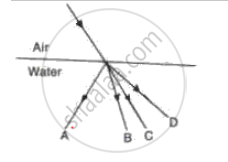
Fill in the blank to complete the following sentence:
When light travels from a rarer to a denser medium, it bends ...........
In the fig., PO is a ray of light incident on a rectangular glass block.
(a) Complete the path of the ray through the block.
(b) In the diagram, mark the angle of incidence (i) and the angle of refraction (r) at the first interface. How is the refractive index of glass related to the angles I and r?
(c) Mark angle of emergence by the letter e. How are the angles i and e related?
(d) Which two rays are parallel to each other? Name them.
(e) Indicate in the diagram the lateral displacement between the emergent ray and the incident ray.
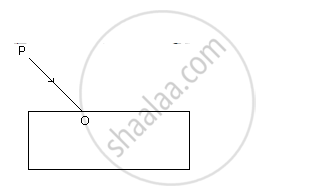
Fig. shows a ray of white light that passes through a prism and produces a spectrum.
(a) Name the phenomenon that is taking place.
(b) What colour would you see at X and Y?
(c) What radiation would you detect above X and below Y?
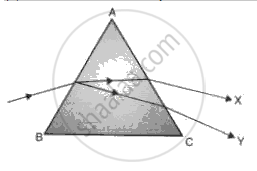
In an experiment of finding the refractive index of glass, if blue light is replaced by the red light, how will the refractive index of glass change? Give reason in support of your answer.
What is meant by the refraction of light?
Why upper surface of water contained in a beaker and above eye level appears silvery?
Glass is transparent in nature. Why does glass powder look opaque? When water is poured over it, it again becomes transparent. Why?
A ray of light passes from water to air. How does the speed of light change?
Why is the colour red used as a sign of danger?
During sunset and sunrise, the sun is seen when it is slightly below the horizon. Give reason.
A glass slab is placed over a page on which the word VIBGYOR is printed with each letter in its corresponding colour.
- Will the image of all the letters be in the same place?
- If not, the state which letter will be raised to the maximum. Give a reason for your answer.
What is the refractive index of water
Comment on the statement ‘The refractive index of glass is 3/2.’
How is the refractive index of a medium related to its real depth and apparent depth?
In what condition a prism is said to be in the position of minimum deviation? What is the direction of the refracted ray inside the prism in this condition?
What do you understand by the deviation produced by a prism?
You are provided with a printed piece of paper. Using this paper how will you differentiate between a convex lens and a concave lens?
Draw ray of light bending towards the normal while passing from glass to water. Label your diagrams.
Complete the ray diagram showing its emergence into the air after passing through the prism.
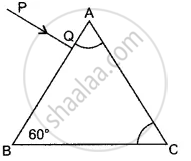
A ray of monochromatic light is incident from the air on a glass slab:
(i) Draw a labelled ray diagram showing the change in the path of the ray till it emerges from the glass slab.
(ii) Name the two rays that are parallel to each other.
(iii) Mark the lateral displacement in your diagram.
The diagram shows the path of a ray of light through a rectangular glass block placed in a liquid of uniform density.

What is the angular, deviation of the emergent ray from the glass block with respect to the incident ray?
Explain with the help of a diagram of how fish is able to see the objects above it.
The velocity of light in diamond is 121000 kms-1. What is its refractive index?
The path of a ray of light coming from air passing through a rectangular glass slab traced by four students are shown as A, B, C and D in the figure. Which one of them is correct?
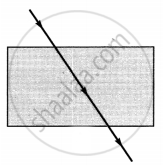 |
 |
 |
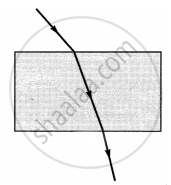 |
| A | B | C | D |
